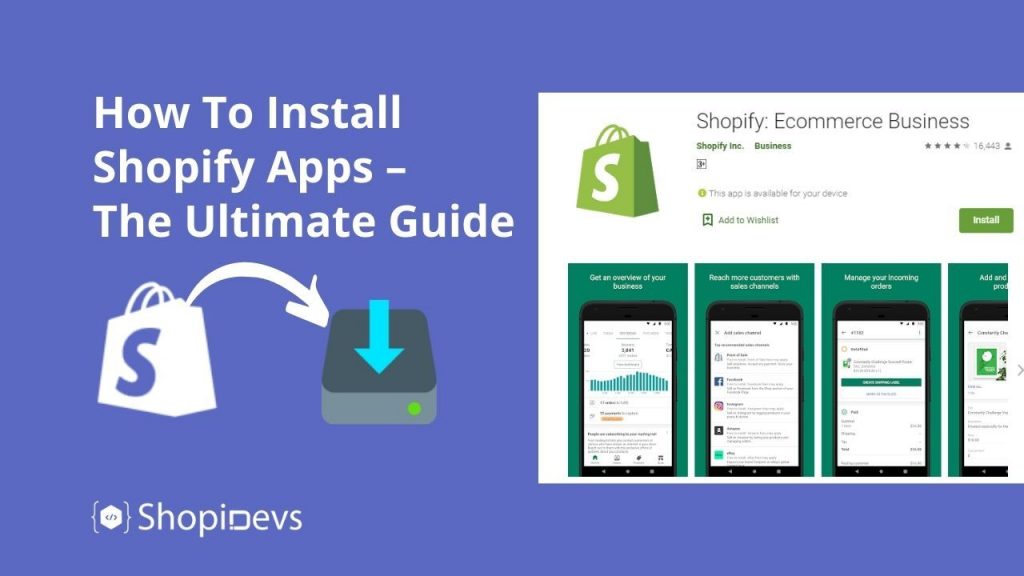If you offer any products or services online, surely you’ve heard of the Shopify platform. It’s an all-in-one solution that makes it easy for you to build, track and grow your online store. This service is offered in exchange for a subscription. However, it should be noted that the monthly rate applied by this online sales platform is quite low.
In addition, its interface is easy to learn and its services are of optimal quality. Considering the many advantages it offers, it is a great idea to do business online in partnership with the Shopify platform. However, at one point or another, you’ll need to install apps on Shopify.
Although this is a fairly simple maneuver and accessible to all, it is not always easy to find your way around. To do this, find here all the information and tips that will allow you to install an application on Shopify.
What are the different categories of Shopify apps?

Before proceeding with the installation of a Shopify app, you should first know the types of apps. Indeed, much more than you can imagine, the Shopify online sales platform is big and dynamic. So it’s not easy to find the best Shopify app without wasting a lot of time researching. So, know that you can install three types of Shopify applications: public, private, and custom.
However, in the app store, you only have the option to directly install public ones. As for private and custom Shopify apps, they are not listed in the App Store. In case you want to install a Shopify application that belongs to these two categories, you will necessarily need to hire a Shopify expert or a platform developer. Indeed, only these professionals will be able to develop these integrations for your e-commerce site. This means that Shopify’s private and personalized applications are not directly accessible to the public.
How do Shopify apps work?
In its design, Shopify makes possible the integration or communication between the installed applications and your online store. The most basic form that illustrates how these apps work is changing the theme of your storefront. Indeed, some applications take care of injecting styles, codes, or scripts into the theme. Also, when your customers browse the e-commerce site, these applications are able to collect information through the storefront. It must be said that in the majority of cases, the Shopify applications that work in this way are oriented towards your customers and potential customers. As an illustration, such a Shopify app can allow you to show your visitors a window that offers a discount on your products or services. The goal, in general, is therefore to help you increase your conversion rate and your sales.
Then, we find the applications that work thanks to integration by the Shopify API. With this way of working, the Shopify application is able to access the data available on your online store and carry out the processing according to your needs. This is usually data relating to orders, customers, products, and more. Constituting a real database for all internal applications, this data is used in real-time. For example, here we find the applications that allow you to do emailing or manage stocks. They are mainly used by the team of the online store. At the same time, you will find Shopify applications whose operation combines the two modes presented above. They, therefore, use API access, but also modify the theme of your online store.
Summary
It should be noted that Shopify has real-time notification management technology. This channel is especially useful for:
- Order tracking applications;
- Shopify parcel tracking applications;
- Shopify customer review applications;
- Shopify tracking applications;
- Inventory management applications and others.
The webhook allows you to make the right decisions at the right time for the smooth running of your online business.
How do I install an app on Shopify from the App Store?
Now that you know a little more about the different types of apps available in the Shopify store and how they work, you can now move on to the installation step. In itself, it must be said that the procedure is quite simple and easy. However, there are a few key points to consider during the process. The very first thing to know is that you can access the app store from your Shopify admin interface. In fact, on the “applications” page, you will find a button at the top that will redirect you to the store.
Also, you can click on this link to access the page. Once on the Shopify app store, you have the opportunity to learn more about the app you want to install. The page provides general information on the features, but also the requirements for the operation of the Shopify application. However, before proceeding with the actual installation, here are the items to check absolutely.
The elements to take into account on the page of the application to install
After knowing the layout and features of the Shopify app to install, there are basically three things you need to check on the page.
- Help section
This section should provide as much information as possible and offer several support options. You should ideally find there the link to a Shopify application developer, the support contact (phone number, email, etc.), the privacy policy, and a link that redirects to an FAQ. It should be noted that former users can also help you in case of any difficulties. To do this, it would be interesting for the application to have an extended user network to its credit.
- The prices section
For each Shopify app, you should know that the pricing structure is different. Where some offer a standard price, others opt for pricing based on your usage. It is therefore up to you to ensure that the information contained in this section meets your budget as well as your expectations. In addition, be aware that almost all applications offer you a free trial period which takes effect upon installation. Make sure you enjoy this time.
- User reviews
To know that an application is really interesting, the ratings and opinions left by users are a track that should not be trivialized. So when a Shopify app has a lot of good ratings and positive reviews, you can deduce that it’s actually worth it. Besides, you should also be interested in negative reviews. This will allow you to get an idea of the limits presented by the application and evaluate them.
Other steps to take before installing a Shopify app
When you install a Shopify app, it can generate significant changes to your online store. To do this, it is important to prepare for this eventuality by making your arrangements in advance. Among other things, it is necessary to save the data of your website. If you only do this occasionally, you should opt for manual backups. To be more efficient, you can only back up data that is in areas of your site that are potentially affected by the installation of the application. You just need to learn about the types of changes to get an idea of the areas that may be affected.
The steps to install an app on Shopify
Now we will discuss how to install Shopify apps. Whether it’s installing a Shopify product page app, a Shopify review app, or a Shopify checkout app, the process remains the same. As soon as you access the page showing the list of applications, you must click on “ add an application ” (“add app”) to add apps to Shopify.
Then you will notice a page explaining the permissions required for the application on the screen. You just have to click on “ show details ” to learn more about all types of access. However, make the difference between “manage” access and “display” access. In case you are satisfied with the permission details, all you have to do is click on the “ Install application ” button.
At this step and depending on the price of the Shopify app you want to install, you will see the “ Approve Fees ” button on the screen . Note that it is possible to pay immediately or at the end of the trial period, it’s up to you. However, if you opt for the second solution, you will need to check the length of the trial period. Also, don’t forget to make sure the price is right.
You should already see that the Shopify app has been installed on your online store. So take the time to explore it and test its features to be sure that it meets your expectations and the needs of your store.
You May Also Read: 15 Best Free Shopify Apps That Boost Your Sales
What is the payment method for Shopify apps?
In general, Shopify apps available in the store (those that are neither private nor personalized) will use the same model as all other Shopify payments. Thus, the fees for the app you just installed will appear on the same invoice like the one that allows you to pay the Shopify platform itself.
If you don’t opt for an annual subscription or for a pay-as-you-go payment, you’ll be billed for the app every month. In addition, in case you do not want to use the application after the trial period, it is advisable to uninstall it well before the last day. This is because Shopify does the billing in advance. By taking this arrangement, you do not risk paying in a vacuum.
How to effectively uninstall a Shopify app?
It must be admitted that the uninstallation process is much more complex than that of the installation. Usually, the only person who is able to help you is the plug-in developer. You will easily be able to contact him if there is a link on the “support section” of the application page to his page. However, here are some simple tips that can help you successfully uninstall a Shopify app without causing damage to your online store.
Make backups
To successfully uninstall a Shopify app, you need to perform backups before installing it. This will allow you to undo any changes that have recently been made to the online store at the appropriate time. This is without a doubt one of the most important precautions.
Get in touch with a developer
When you want to uninstall a Shopify app, you need to contact a Shopify developer. He will be able to give you the procedure to follow to completely and properly remove the application from your online sales site. It will also warn you about possible risks.
Back up the theme files
There are many mobile and non-mobile Shopify apps that make significant changes to the storefront theme. To do this, you should also have the option to revert to an older version of your storefront. So back up the theme files regularly.
Take notes
In the case of a manual installation, you should keep notes that provide information on the various changes. This will allow you to better manage the uninstallation. Also, in general, it is a good idea to be aware of anything going on in the background when installing a Shopify app.
In definition, here is a detailed guide on the process to follow to install a Shopify application. While the process is fairly straightforward, you need to keep your eyes open and make arrangements to avoid unpleasant surprises. If in doubt, don’t hesitate to seek advice from a Shopify developer or former app user. Also, remember that making regular backups is vital.
I’m a digital marketing expert and mobile app developer with a deep understanding of Shopify App Store optimization. I contribute insightful articles on Shopify to help businesses thrive online.



